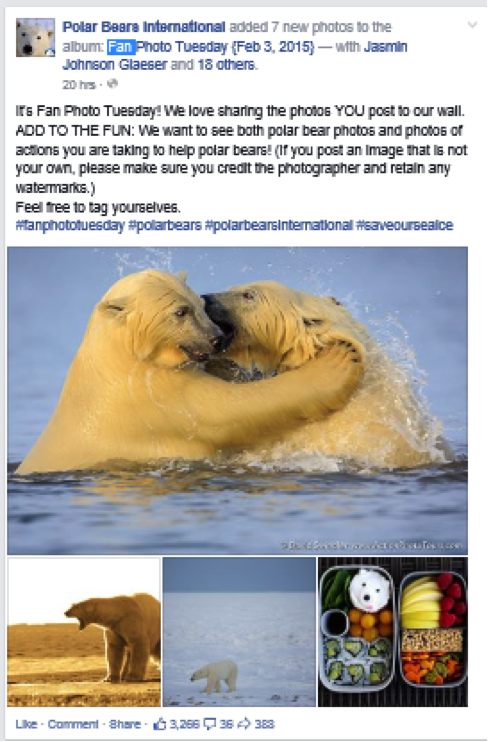
It is certainly no secret that on Facebook and other social channels, the more viral a nonprofit’s content, the more likely it is to be seen by a wider audience of potential supporters. This is why most organizations focus so much time creating content that will drive people to interact with it, whether that means liking or sharing it or taking some deeper action like leaving a comment or signing a social petition. And with the speed at which social content comes and goes, creating a constant stream of new content can be immensely time-consuming and can frankly burnout the person responsible for social media – who, if your organization is like many, wears several other hats.
Luckily, organizations really don’t need to approach the challenge on their own. The most successful Facebook pages use a mix of content and much of it comes from, or is inspired by other people. Having the right mix of curated, user generated and borrowed content really does create a virtuous cycle. A good mix enables you to increase the number of posts you create which leads to greater news feed presence and greater awareness. This, in turn, leads to increased engagement and yet even more news feed views.
But what should the mix look like? Here’s how to start:
Content Marketing Strategy 1: Curate!
Experts love to quote 80-20 rules. And when finding the balance between totally original content versus content that is curated, the 80/20 is often cited. But it may surprise you to hear that just 20% of your content really should be totally original content, while 80% of your posts should contain, or at least be inspired by, content generated outside your organization. This doesn’t mean you should just randomly find and post pictures of cute kittens rolling around in the snow. Organizations should strategically post content from outside sources that accelerates the discovery of material that supports your mission.
- For example: If your organizational mission is to eradicate illiteracy in the Southwest US, find like-minded organizations-perhaps ones focused on the same mission in other geographies. Then track what they are posting and draw inspiration from their best performing content. A community of organizations with similar missions and allied content can provide both an ongoing source of quality content, and you may find that they will reciprocate by sharing your content as well.
- To help streamline the process of finding this content, I recommend organizations create a Twitter List and a Facebook Interest List. These lists will automatically capture the content streams of organizations and topic areas you designate. Having this stream at your fingertips allows you to quickly scroll through and find relevant content that people are already talking about – the first step to creating virality.
Content Marketing Strategy 2: Borrowed Content
Borrowed and curated might sound similar but they are bit different. Curated content is generally new items you’ve found on Facebook or Twitter that you’re sharing. Borrowed content is content that other people have placed on the Internet specifically for the purpose of having it shared. When you borrow content, you are helping the author by giving them an SEO boost and benefiting your audience by giving them a third party – often expert – perspective on a given topic. Which, is unlikely to be cute kittens, unless your mission happens to be to support kittens or snow, or… You get the point; everything you post to your social channels should strategically support your organization’s mission and social media objectives.
Also, remember that social media is public and therefore the content you choose to borrow should be content that people want their friends, family, colleagues, etc. to see that they are interacting with. Before you post, ask yourself, ‘would I want to be seen engaging with this content?’ If the answer is ‘no’, choose other content to borrow.
Content Marketing Strategy 3: User Generated Content
Your supporters and fans can be a great source of content for your nonprofit to use on any channel. When setting out to tap your users to help generate content, keep a few things in mind:
- Be specific. Are you looking for stories of breast cancer survivors? Or, pictures from the Cure for Cancer run? While users love to participate in calls for content, without specifics you’re guaranteed to get everything and the kitchen sink. For example, Polar Bears International features “Fan Photo Tuesday” in which they make a specific Photo request.
- Tap into your supporters’ passions. Do your supporters love their pets? Running? Reading? Identify the common passion(s) among your supporters and link your call for content to it.
- Reward contributors. Relationships are a two way street. Make sure you’re giving back to the people who are generating content for you. If you can, say thank you to each and every person who submits content. A simple thank you goes a long way toward building lasting relationships. Also, let them know how they are helping further your mission with their support.
User Generated Content can spur additional participation from supporters as they look to find other ways to support the mission they have created content around, entangling their story with yours in a wonderful way. In this way, supporters are more likely to share this type of content with their networks, helping further your overall social media goals.
As you work to balance your social content strategy, keep in mind that each piece of content you post really is independent of your other content. Because each piece stands on its own merits, don’t be afraid to try something new; if it bombs and doesn’t spread, that simply means very few people saw it but single low performing posts will not impact the success of future content. Second, as the person responsible for social content, you are also responsible for analyzing content success and learning how to do better day after day. Study the numbers and determine what types of content – including message, tone and mechanism, such as video, still image or poll – play best with your supporters and use what you learn to fine-tune future content, keeping the 80-20 rule at play. You’ll appreciate the extra traction your content gets and the time you have to develop strategy, not just new content
.
About the Author: Drew Bernard is the founder and CEO of ActionSprout.com where he and his team build tools that help nonprofits and political campaigns succeed on Facebook and beyond. Follow him on Twitter: @drewbernard


